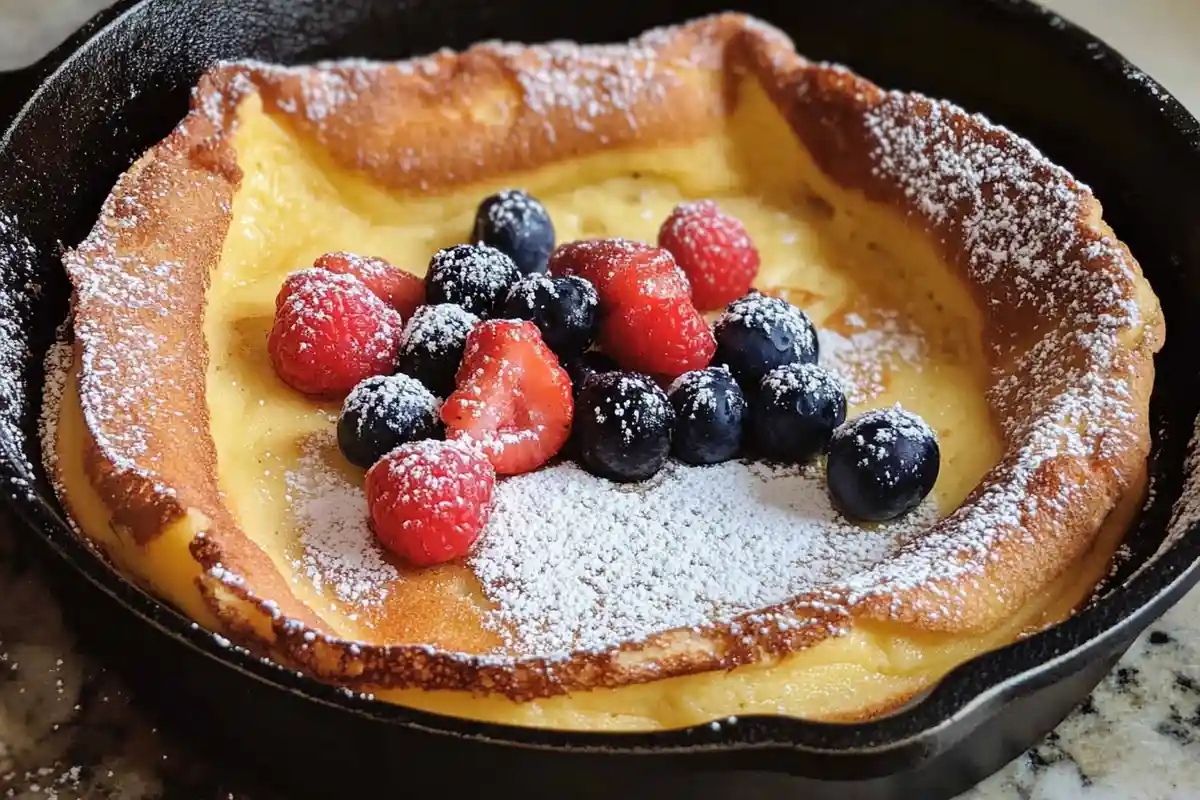Sourdough discard has gained massive popularity among home bakers, and pairing it with the classic Dutch baby pancakes is nothing short of culinary magic. A sourdough discard Dutch baby is fluffy, slightly tangy, and beautifully golden—a perfect blend of simplicity and sophistication. This article will explore everything from understanding the key ingredients and their roles to troubleshooting common mistakes. Whether you’re a seasoned baker or just getting started with sourdough, this guide will equip you with the knowledge and confidence to master this delightful dish. Now, let’s dive right into it!
Table of Contents
Introduction to Sourdough Discard and Dutch Baby
What is Sourdough Discard?
If you’ve ever worked with sourdough, you’re probably familiar with sourdough discard. The portion of the starter is removed during the feeding process to maintain balance and prevent it from overflowing. While it might seem like a waste, this discard is a goldmine of flavor and texture. Rich in natural yeast and slightly tangy in taste, it’s a versatile ingredient that can be used in countless recipes, from pancakes to crackers and—yes, you guessed it—Dutch babies!
What is a Dutch Baby Pancake?
The Dutch baby pancake is a delightful hybrid between a pancake, a crepe, and a popover. Originating from Germany, this oven-baked pancake puffs up dramatically as it cooks, forming golden edges and a soft, custardy center. Unlike traditional pancakes cooked on a skillet, Dutch babies are baked in a preheated cast-iron skillet, ensuring even heat distribution. They’re incredibly versatile and can be enjoyed sweet or savory, depending on your preference.
Combining Sourdough Discard with Dutch Baby
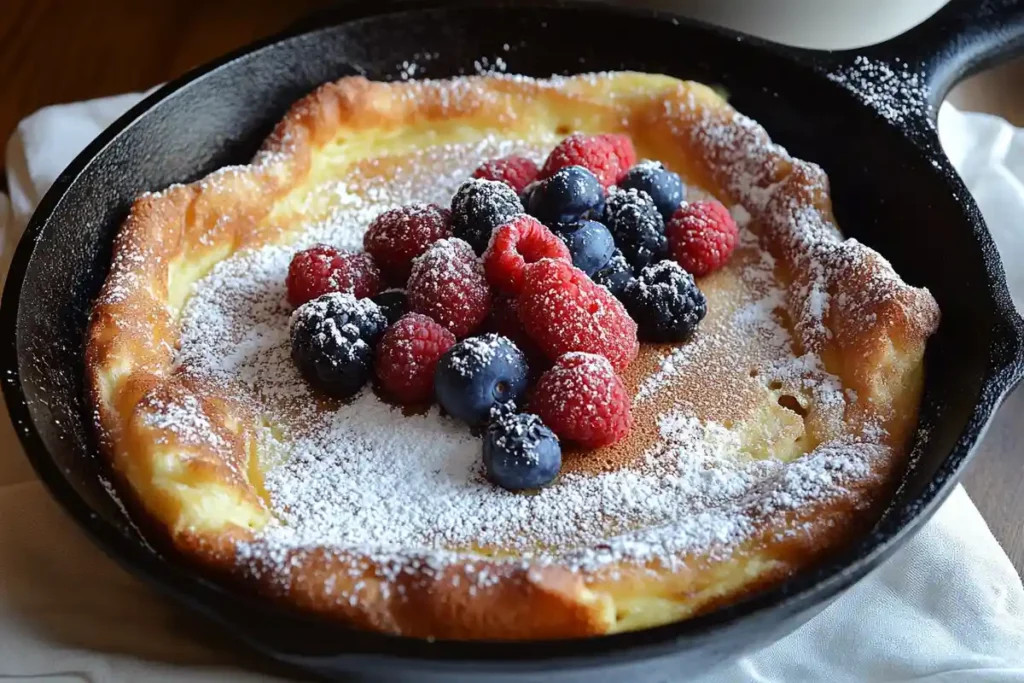
So, why combine sourdough discard with a Dutch baby pancake? The answer lies in the unique characteristics of sourdough discard—it adds a subtle tanginess and enhances the overall flavor profile. Plus, it’s an excellent way to minimize waste in the kitchen. The natural yeast in the discard helps achieve an airy, cloud-like texture while contributing to the pancake’s signature puff. The result? A beautifully golden, slightly crispy-edged pancake with a depth of flavor that sets it apart from the classic version.
This harmonious pairing of sourdough discard and Dutch baby isn’t just a trend—it’s a delicious innovation that brings sustainability and taste together on a single plate. Ready to explore the benefits of this dynamic duo? Let’s move on!
Benefits of Using Sourdough Discard in Dutch Baby Recipes
Enhanced Flavor Profile
One of the most compelling reasons to use sourdough discard in a Dutch baby pancake is the remarkable depth of flavor it adds. Traditional Dutch babies have a mild, eggy taste, but when sourdough discard enters the mix, it brings a subtle tanginess that elevates the entire dish. This gentle acidity balances the richness of the eggs and butter, creating a more complex and satisfying flavor profile.
Moreover, the fermentation process in sourdough introduces natural umami notes, giving the pancake an irresistible savoriness even in sweet variations. The sourdough-enhanced flavor shines through beautifully, whether paired with fresh berries, powdered sugar, or a drizzle of maple syrup.
Reducing Food Waste
In a world where minimizing waste is becoming increasingly important, sourdough discarding is an excellent sustainable kitchen practice. Every time you refresh your sourdough starter, you’re left with a portion of discard that many people toss away. But why waste something so valuable?
Incorporating sourdough discard into your Dutch baby recipes ensures nothing goes to waste. This eco-friendly approach reduces your kitchen footprint and saves money by using an ingredient you’d otherwise throw out. It’s a win-win scenario where resourcefulness meets culinary delight.
Nutritional Advantages
Beyond taste and sustainability, sourdough discard Dutch baby pancakes have impressive nutritional perks. Sourdough discard contains beneficial lactic acid bacteria thanks to the natural fermentation process. These good bacteria can improve digestion and help your body absorb nutrients more effectively.
Additionally, sourdough discard may lower the glycemic index of baked goods, offering a slower release of sugars into the bloodstream. It means your sourdough discard Dutch baby might keep you feeling fuller for longer—especially when paired with protein-rich toppings like Greek yogurt or nut butter.
Step-by-Step Guide to Making Sourdough Discard Dutch Baby
Ingredients Needed
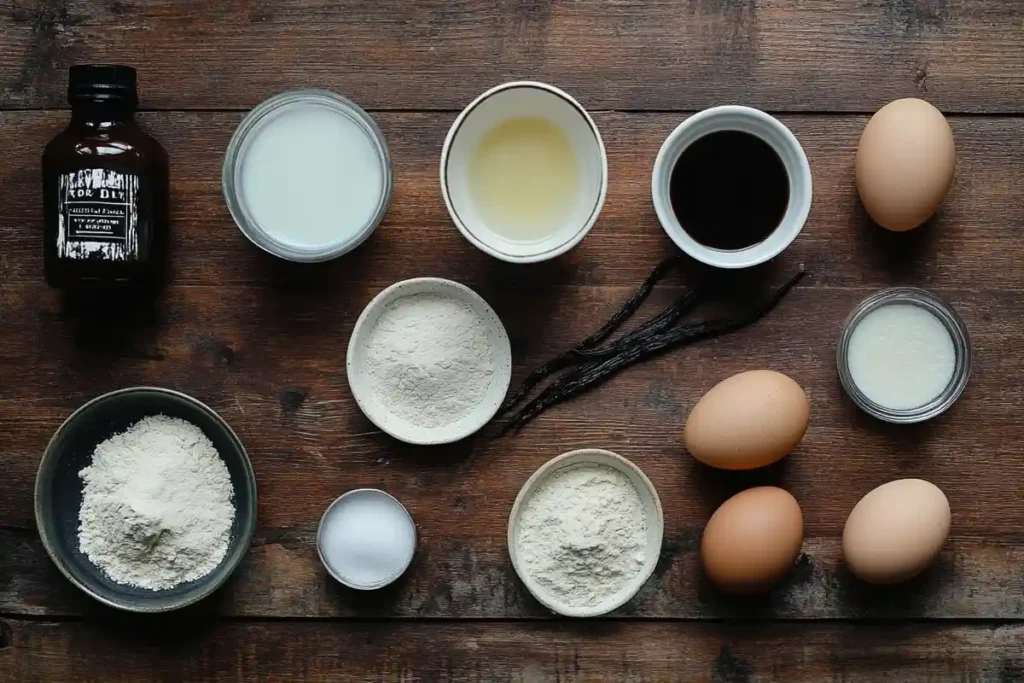
Before diving into the preparation, let’s gather the key ingredients for your sourdough discard Dutch baby. Simplicity is the heart of this recipe, but each ingredient plays a crucial role:
- ½ cup sourdough discard (unfed, room temperature)
- 3 large eggs (room temperature)
- ½ cup all-purpose flour
- ½ cup whole milk (room temperature)
- 2 tablespoons granulated sugar
- 1 teaspoon vanilla extract
- ¼ teaspoon salt
- 2 tablespoons unsalted butter (for the skillet)
Feel free to add your favorite toppings, such as fresh berries, powdered sugar, maple syrup, or savory options like sautéed mushrooms and herbs.
Equipment Required
While the ingredient list is straightforward, the right tools will ensure your Dutch baby pancake rises perfectly:
- A 10-inch cast iron skillet (preheated)
- A mixing bowl
- A whisk or blender (for a smooth batter)
- An oven mitt (safety first!)
- A sifter (for dusting powdered sugar, optional)
Preparation Steps
Ready to whip up your sourdough discard Dutch baby? Follow these easy steps:
- Preheat the Oven and Skillet:
- Preheat your oven to 425°F (220°C). Place your cast iron skillet inside while the oven heats up. This step ensures the batter starts cooking immediately upon contact.
- Make the Batter:
- Whisk together the sourdough discard, eggs, flour, milk, sugar, vanilla extract, and salt in a mixing bowl. For an extra smooth batter, you can use a blender. The consistency should be thin and pourable—similar to heavy cream.
- Melt the Butter:
- Once the oven and skillet are fully heated, carefully remove the skillet (use oven mitts!) and add the butter. Swirl it around until it is fully melted and evenly coats the skillet.
- Pour the Batter:
- Quickly pour the batter into the hot skillet and return it to the oven.
Baking Instructions
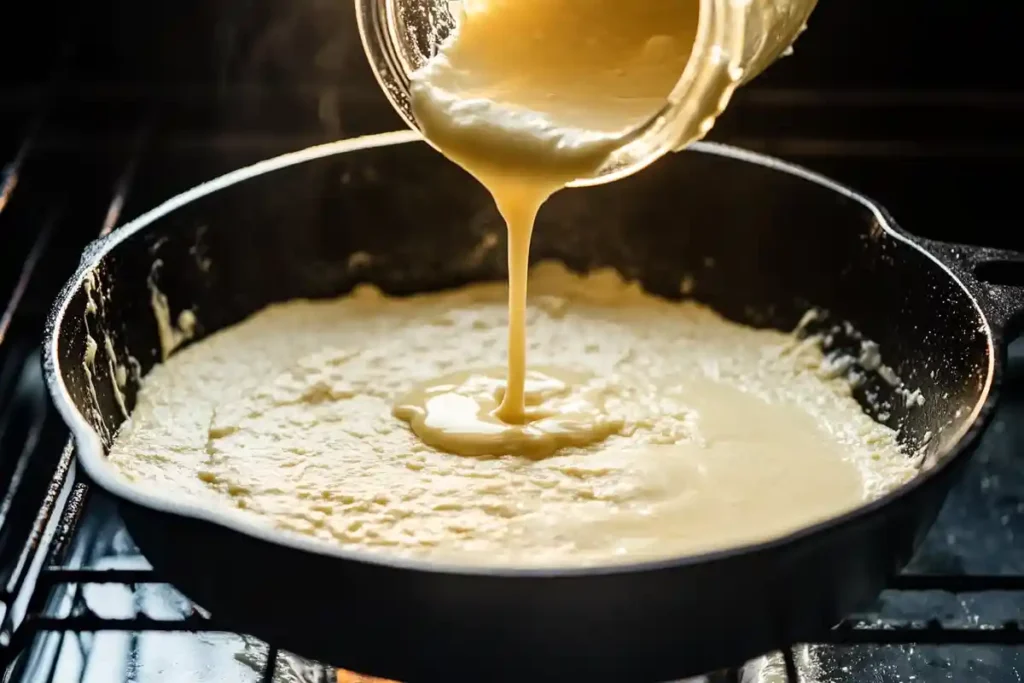
Bake your sourdough discard Dutch baby for 15–20 minutes without opening the oven door. The pancake will puff dramatically around the edges and turn golden brown. Resist the temptation to peek—it could cause the pancake to deflate!
Once fully baked, remove the skillet from the oven. The pancake will start to sink slightly in the center—perfectly normal.
Serving Suggestions
Now comes the best part: serving your masterpiece! Here are some delicious ideas:
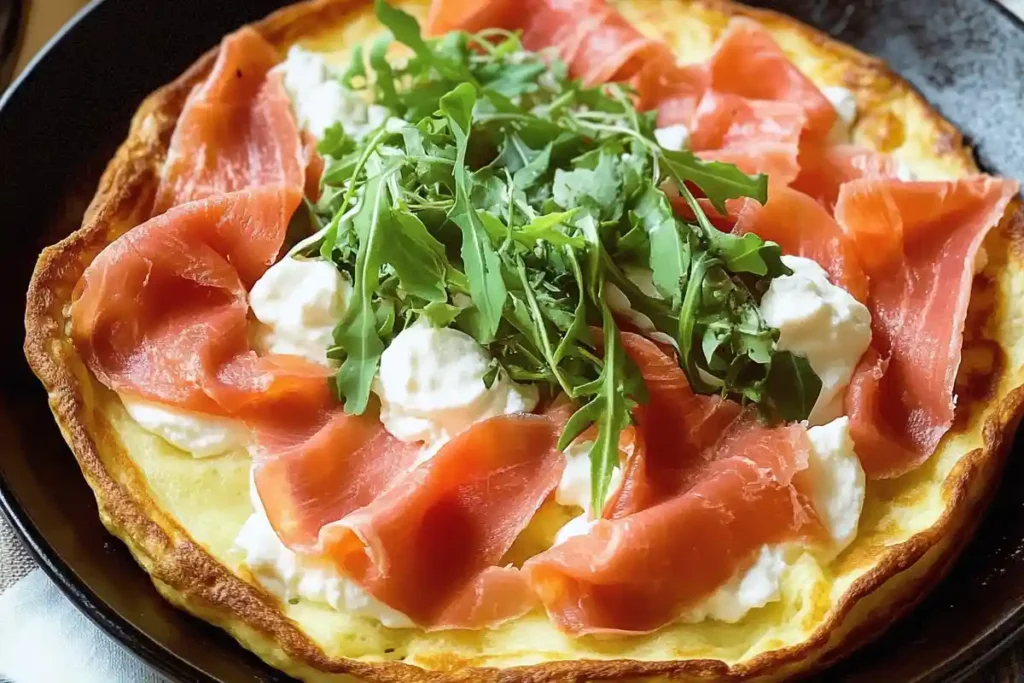
- Sweet Options: Dust with powdered sugar, drizzle with maple syrup or add fresh berries.
- Savory Options: Top with smoked salmon, cream cheese, or a fried egg.
- Extra Indulgence: Add whipped cream or a dollop of lemon curd.
Serve your sourdough discard Dutch baby immediately for the best texture and flavor. It’s a showstopper straight from the skillet, so enjoy every fluffy, tangy bite!
Troubleshooting Common Issues
Even the most experienced bakers face hiccups when making a sourdough discard Dutch baby. But don’t worry—most problems have simple solutions. Let’s address some common issues so you can perfect your pancake every time.
Why Did My Dutch Baby Not Puff Up?
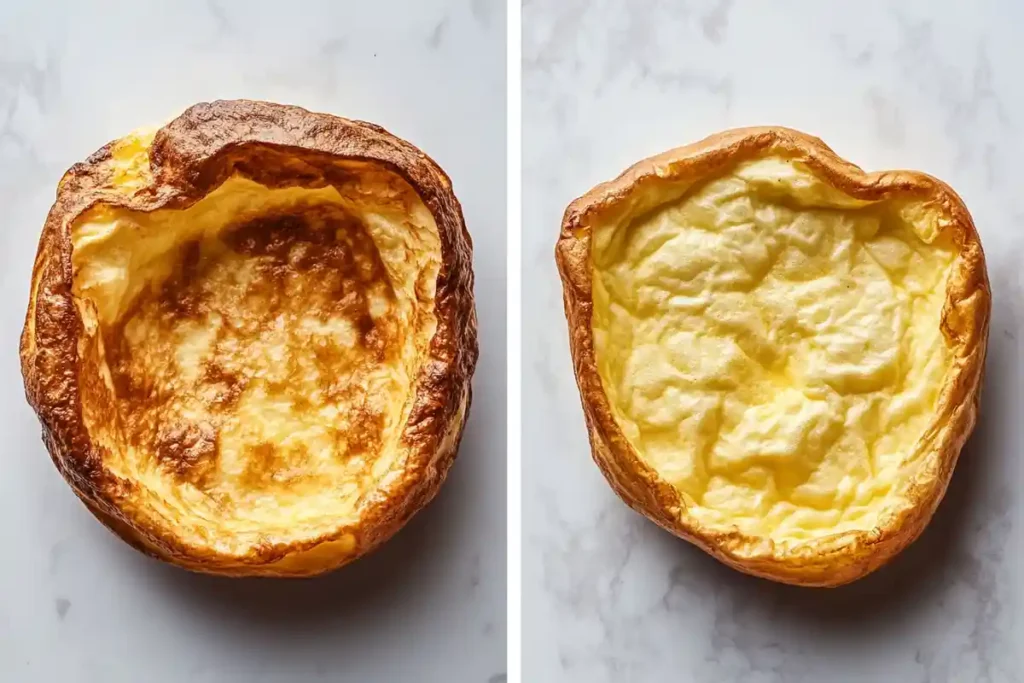
One of the most disappointing moments is pulling your Dutch baby out of the oven and finding it flat instead of gloriously puffed. Here are some common reasons:
- Cold Ingredients: If your eggs, milk, or sourdough discard are cold, the batter won’t rise properly. Always use room-temperature ingredients.
- Skillet Not Hot Enough: The skillet must scream hot when you pour the batter. If it’s not, the batter won’t puff as it should.
- Overmixing the Batter: While a smooth batter is essential, overmixing can develop too much gluten, resulting in a dense pancake.
- Oven Temperature Fluctuations: Consistent high heat is crucial. Avoid opening the oven door while baking, as heat loss can prevent the pancake from rising.
Pro Tip: Always preheat your skillet and oven thoroughly, and pour the batter in quickly to maintain heat.
Achieving the Right Texture
The texture is everything in a sourdough discard Dutch baby. The edges should be crisp and golden, while the center remains soft and custardy. Here’s how to nail it:
- Egg Balance: Eggs give the Dutch baby its signature custardy center. However, too many eggs can make it overly dense. Follow the recipe ratios closely.
- Flour Consistency: Use all-purpose flour to balance structure and tenderness. Avoid heavy or low-protein flours.
- Proper Mixing: A silky smooth batter is key. If you notice lumps, strain the batter through a fine-mesh sieve before pouring it into the skillet.
Avoiding Overly Eggy Flavor
Some bakers find their Dutch baby tastes overwhelmingly eggy. While eggs are a core ingredient, there are ways to balance their flavor:
- Add Vanilla or Citrus Zest: A teaspoon of vanilla extract or a pinch of lemon zest can counteract the egginess beautifully.
- Use Fresh Eggs: Older eggs can develop a stronger smell and taste. Always opt for fresh, high-quality eggs.
- Incorporate Sugar or Sweeteners: A little sugar in the batter can help mask egg-heavy flavors.
Preventing Deflation After Baking
It’s natural for your Dutch baby to sink slightly after it comes out of the oven, but if it collapses completely, something might’ve gone wrong:
- Bake Thoroughly: Undercooked pancakes will collapse as they cool. Ensure the edges are golden and crisp before removing them from the oven.
- Serve Immediately: Dutch babies are best served fresh. Letting them sit too long will result in deflation and a loss of texture.
Quick Recap for Troubleshooting Success
- Preheat the oven and skillet properly.
- Use room-temperature ingredients.
- Avoid overmixing the batter.
- Don’t open the oven door during baking.
- Serve immediately for the best results.
Now that you’re equipped with these troubleshooting tips, it’s time to address some frequently asked questions about sourdough discard Dutch baby pancakes. Let’s clear up those lingering doubts!
Frequently Asked Questions (FAQs)
What is the Easiest Way to Use Sourdough Discard?
The easiest way to use sourdough discard is to incorporate it into simple, quick recipes like pancakes, waffles, muffins, or crackers. These dishes don’t require additional fermentation time, making them perfect for using leftover discard. A sourdough discard Dutch baby is particularly convenient because it’s a one-bowl recipe that delivers maximum flavor with minimal effort. Plus, the batter comes together in minutes!
Can I Leave Sourdough Discard Out Overnight?
Yes, you can leave sourdough discarded overnight, but only under specific conditions. If your kitchen is relatively cool and the discard is unfed, it can sit out for up to 12 hours. However, if temperatures are warmer, storing it in the refrigerator is safer to prevent over-fermentation or spoilage. Always give it a quick sniff before use—discard anything that smells unpleasant or shows signs of mold and should be thrown away.
Are Dutch Babies Supposed to Be Eggy?
Dutch babies are naturally eggy, but the flavor shouldn’t be overpowering. Eggs are crucial in achieving the custardy texture and impressive puff of a Dutch baby. If the egginess is too strong, add a splash of vanilla extract, a sprinkle of cinnamon, or a bit of lemon zest to balance the flavor.
How Do I Know My Dutch Baby is Fully Cooked?
A fully cooked sourdough discard Dutch baby will have puffed golden brown and crisp edges, while the center will be soft but not overly wet. The pancake should hold its structure when removed from the oven, with the edges slightly pulling away from the sides of the skillet. If in doubt, bake for 2–3 minutes to ensure the center sets properly.
Can I Make a Savory Version of Sourdough Discard Dutch Baby?
Absolutely! Savory sourdough discard Dutch babies are just as delicious as sweet ones. Simply reduce or omit the sugar in the batter, and add savory toppings like sautéed mushrooms, caramelized onions, fresh herbs, or grated cheese. A dollop of sour cream or crème fraîche also pairs beautifully with a delicious Dutch baby.
What’s the Best Way to Serve a Dutch Baby Pancake?
A sourdough discard Dutch baby is best served straight out of the oven. Try classic toppings like powdered sugar, maple syrup, fresh berries, or whipped cream for sweet versions. For savory versions, go for sautéed vegetables, cured meats, or a poached egg on top. The sky’s the limit—get creative and tailor it to your taste!
Final Thoughts on Sourdough Discard Dutch Baby
From its crispy edges to its soft, custardy center, a sourdough discard Dutch baby is a true kitchen gem. Not only does it minimize food waste, but it also offers a delicious canvas for both sweet and savory toppings. This guide gives you all the tools, tips, and tricks to master this recipe. So, preheat that skillet, grab your sourdough discard, and let the magic unfold in your oven. Happy baking!

